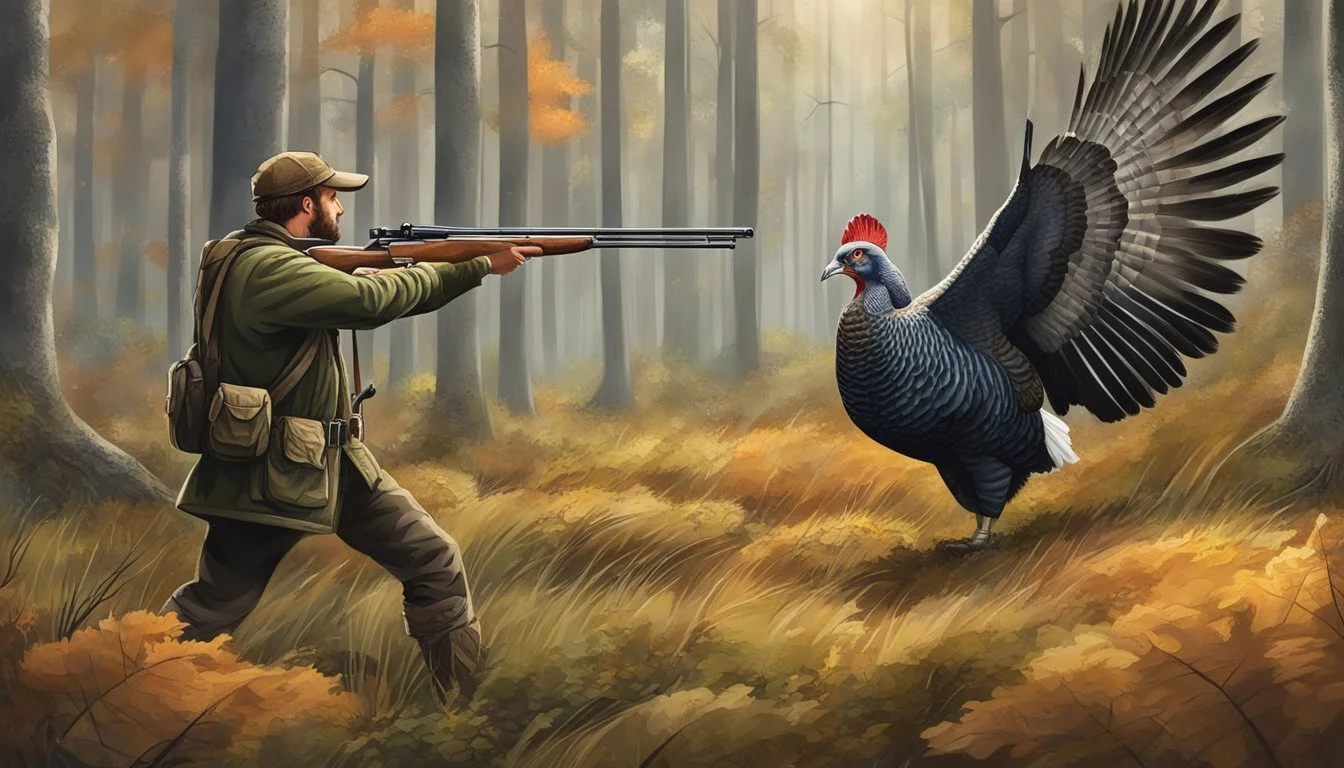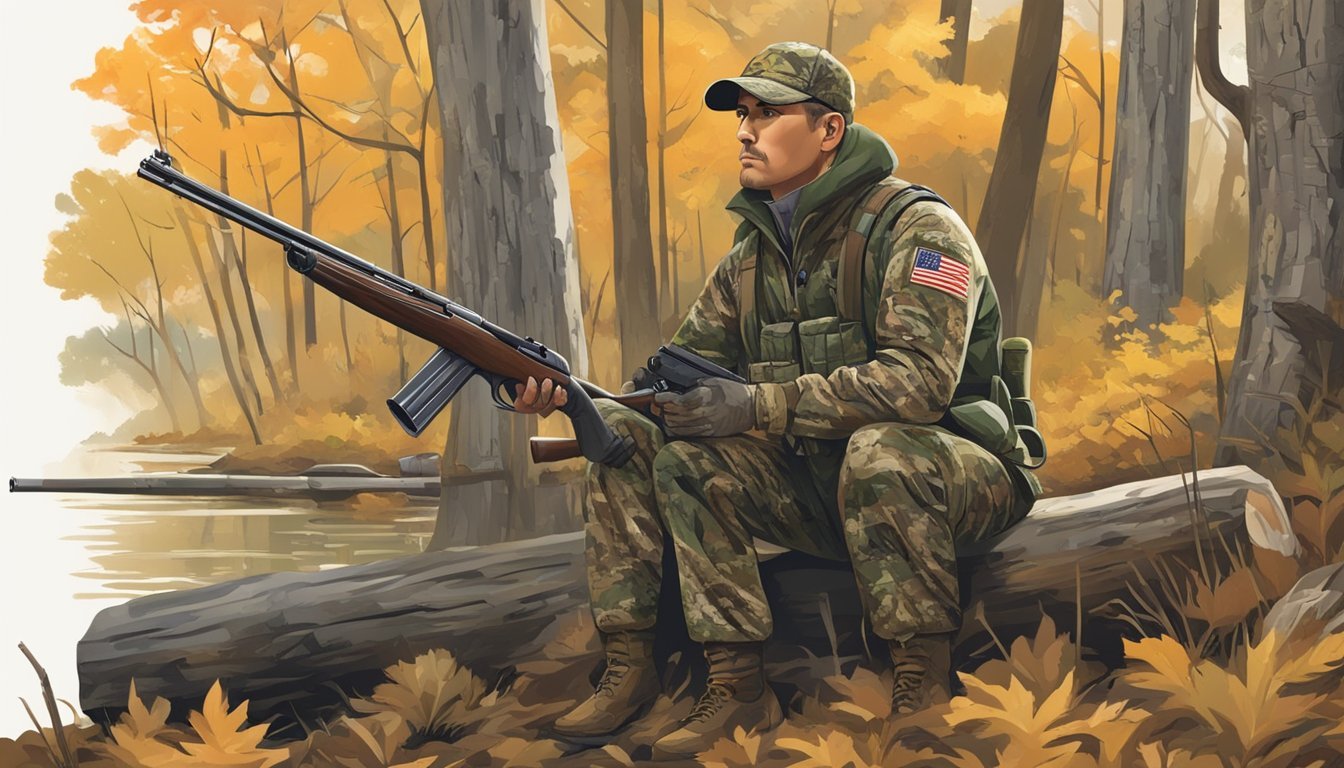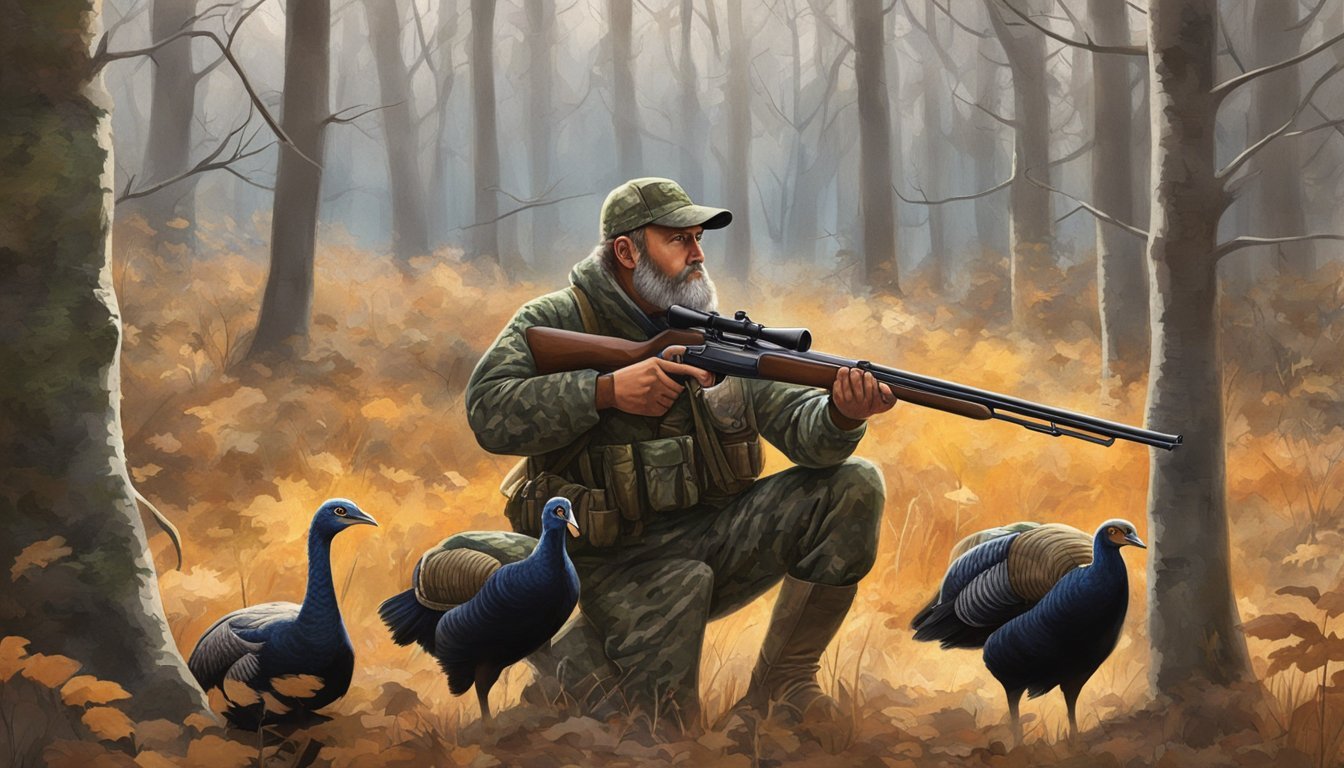Turkey Hunting Seasons
Know Your Dates for a Successful Hunt
This Article is Part of Our Guide on Hunting Seasons for Over 70 Common Game Species
Turkey (What wine goes well with turkey?) hunting is a cherished tradition in the United States, attracting countless outdoor enthusiasts each year. The sport hinges on tracking and calling wild turkeys, a bird that has become a symbol of American wildlife and hunting culture. Seasonal regulations for turkey hunting are established to promote sustainable hunting practices while ensuring the stability of wild turkey populations. Fall turkey hunting, which is steep in heritage, once stood as the primary season; however, the rise of turkey populations in the latter half of the 20th century introduced spring seasons, transforming the landscape of the practice.
The spring turkey hunting season generally garners greater attention due to the mating rituals of gobblers, or male turkeys, which make them more active and vocal, hence, easier to locate. On the contrary, the fall season offers a different challenge, as hunters capitalize on the turkeys' flocking behavior to effectively harvest both male and female birds. Throughout the United States, more than 40 states have established fall turkey seasons, with each jurisdiction setting forth specific regulations and time frames to guide ethical and effective hunting practices.
Understanding the behavioral patterns and habitat of wild turkeys is crucial for a successful hunt. Experience and comprehensive knowledge about these birds are what seasoned hunters rely on to navigate the woods and fields, whether in fall or spring. Regulations, such as bag limits and legal hunting hours, are in place to ensure the sport remains an ethical pursuit, respecting the natural cycles and conservation efforts associated with the species. Hunters are encouraged to stay well-informed of their local rules, which can be found in state-issued guides and through various hunting organizations.
Understanding Turkey Seasons
Turkey hunting seasons are delineated into spring and fall periods, each with its distinct dates and regulations, providing hunters with ample opportunities for pursuing these birds.
Spring Turkey Season
Season Dates: Spring turkey season typically commences in March with exact starting dates varying by state. In some southern regions, such as southern Florida, the season begins on the first Saturday in March. Regulations: This season corresponds with the turkey mating period, during which gobblers are more responsive to calls. Hunters often employ the plain yelp of a hen to lure in a gobbler.
Bag Limits: Often set by state agencies, these limits determine the number of turkeys a hunter can legally harvest.
Hunting Techniques: A blend of calls and decoys are used to mimic a hen and attract a male turkey.
Fall Turkey Season
Season Dates: Fall turkey season dates vary widely across different states, with many holding hunts from September through November. Regulations: Hunting during this season may require different tactics as turkeys are less vocal and do not respond to calls as in spring. Fall season regulations may include both sex harvests, allowing hunters to take hens as well as gobblers.
Bag Limits: States often set separate bag limits for fall, possibly different from spring seasons.
Hunting Techniques: Hunters may need to rely on more passive tactics such as scouting and patterning birds, as turkeys form larger flocks in fall and may require different strategies to hunt effectively.
State-Specific Regulations and Dates
Turkey hunting seasons and regulations vary by state, with each region having specific start and end dates, bag limits, and legal methods of take. It is imperative that hunters check with their state's wildlife agency for the most current regulations before heading out.
Western States
Alaska: There is no huntable turkey population in Alaska.
Arizona: Spring turkey season typically runs from late March through early May, with bag limits and specific dates varying by zone.
California: Fall and spring turkey hunting seasons are available with variable dates depending on the area.
Colorado: Offers both a spring and fall season; the spring season usually begins in April.
Idaho: Spring season dates begin in April, with controlled hunts requiring application.
Midwestern States
Illinois: The spring season is split into several segments with specific dates throughout April and early May.
Indiana: Spring turkey hunting generally starts in April.
Iowa: Spring turkey seasons are divided into four time periods in April and May.
Kansas: Offers a fall and spring season with archery and regular firearm seasons.
Missouri: Spring turkey hunting begins in April with specific dates for the youth season.
Southern States
Alabama: Spring turkey season runs from March to April, with specific dates varying by zone.
Arkansas: The spring turkey season starts in April, while the fall season dates are subject to annual changes.
Florida: One of the earliest starts for spring turkey season, as early as March in the southern zone.
Georgia: Spring season usually commences in late March and continues through May.
Louisiana: Turkey season dates are typically set for spring, starting in March or April, depending on the area.
Eastern States
Connecticut: Spring turkey season begins in late April, while fall season dates are typically in November.
Delaware: Spring turkey hunting is allowed from April to May.
Maine: Hunters may take to the woods in the spring season starting in late April.
Maryland: Offers a spring turkey season which usually begins in April.
Massachusetts: Spring turkey hunting season typically starts in late April.
Equipment and Techniques
Successful turkey hunting requires both well-chosen equipment and specific techniques. Knowing the right calls, sporting effective camouflage, and employing strategic hunting practices are key to a fruitful hunt.
Turkey Calls
Turkey hunters use a variety of calls to imitate turkey sounds and attract gobblers. Among these, mouth calls are popular for their hands-free operation, allowing hunters to stay concealed. Some common calls include:
Gobble Call: Mimics the gobble of a male turkey to challenge other toms and can be instrumental during the early morning.
Box Calls: Produce a range of turkey sounds with a simple stroke and are great for beginners.
Slate Calls: Offer subtle, soft calls that can work well when turkeys are closer.
Camouflage and Gear
Effective camouflage is essential to avoid detection by turkeys, which have sharp eyesight. Hunters must match their camo patterns to the surrounding environment. A list of gear includes:
Clothing: Textured outfits, such as leafy suits, break up the human silhouette.
Face Mask: Keeps a hunter's face hidden.
Gloves: Camouflages the hands, which move frequently when calling.
For spring hunts, hunters may choose lighter layers, whereas the fall season requires warmer, weather-appropriate gear.
Hunting Strategies
When strategizing for a turkey hunt, hunters consider turkey behavior:
Roosting: Turkeys roost in trees to avoid predators. Hunters locate these sites to plan morning approaches.
Strutting Zones: Toms display their feathers in these areas, especially during the mating season. Hunters may position themselves near these zones to catch turkeys off guard.
Using Decoys: Placing hen or jake decoys can attract a gobbler in search of a mate, offering the hunter a shot opportunity.
Patience and understanding of turkey behavior are critical in executing these strategies effectively.
Turkey Species and Identification
Understanding the differences between turkey species and the nuances of their identification is crucial for a successful and legal hunt. It helps hunters distinguish male from female turkeys, which is essential since in many regions, only males—the gobblers—are legally huntable during certain seasons.
Eastern Turkeys
The Eastern Wild Turkey (Meleagris gallopavo silvestris) is the most populous subspecies in North America. They have a wide range and are recognized by:
Males: Dark, iridescent feathers with a beard (a tuft of coarse feathers) protruding from the breast. During the spring, their heads become more colorful—showcasing red, white, or blue shades.
Habitat: Eastern Turkeys thrive in a diverse array of forests and forest-edge settings across their extensive range.
Rio Grande Turkeys
Rio Grande Wild Turkeys (Meleagris gallopavo intermedia) are known for their preference for somewhat arid habitats compared to their Eastern cousins. Identification features include:
Males: Less iridescence on their feathers than Eastern turkeys and a longer beard. They often display tan-colored tail feather tips.
Habitat: They favor scrubby brush areas near water sources such as streams and rivers, mainly found in the central and southern plains of the United States.
Merriam’s and Gould’s Turkeys
The Merriam's Wild Turkey (Meleagris gallopavo merriami) and Gould’s Wild Turkey (Meleagris gallopavo mexicana) can be harder to find due to more limited ranges.
Merriam's: Distinct with their white-tipped tail feathers and found primarily in the mountainous regions of the western United States.
Gould’s: They have longer legs and larger feet adapted for mountainous environments. They are predominantly found in Mexico but also inhabit parts of the United States Southwest.
Each subspecies' male wild turkeys are the focal point during hunting seasons, and their distinct plumage, vocalizations, and behaviors are key factors in effective identification and ethical hunting.
Hunter Safety and Ethics
Maintaining safety and ethical standards is paramount in turkey hunting, both to preserve the hunting heritage and to support conservation work. The following protocols help ensure the wellbeing of both the hunters and the turkey populations.
Safety Measures
Dress Appropriately: Hunters should never wear red, white, blue, or black, as these colors can be mistaken for a turkey's plumage. It's essential to wear hunter orange when moving through wooded areas to increase visibility to other hunters.
Firearm Handling: It's imperative that one always treats firearms as if they're loaded, keeps the muzzle pointed in a safe direction, and is sure of their target and what's beyond it before taking a shot.
Location Identification: Utilizing hunter orange also helps to visibly mark one's hunting location to others, and a safety harness is a must when using a tree stand.
Hunting Etiquette
Positive Identification: Ethical hunters must identify their target fully, ensuring it's a turkey and not another hunter. Only when the turkey is fully visible and within effective shotgun range should a hunter take a shot.
Respect Bag Limits: Following the established bag limits not only abides by the law but also aids in conservation efforts. After reaching one's limit, they can still participate by calling turkeys for others, but they must not carry a bow or firearm.
Property Respect: Seeking permission before hunting on private land, following the rules of the area, and leaving no trace maintains relationships with landowners and supports ongoing access for hunting activities.
Conservation and Management
In the realm of turkey hunting, effective conservation and astute management are key to sustaining both the sport and the species. The involvement of organizations like the National Wild Turkey Federation (NWTF) underscores the vital relationship between hunting opportunities and wildlife conservation efforts.
Habitat Preservation
Habitat Preservation is a cornerstone of turkey conservation. The NWTF emphasizes the importance of maintaining diverse natural habitats to support thriving turkey populations. Biologists suggest practical measures such as refraining from mowing fields during critical breeding months—March to July—to enhance nesting success and brood rearing.
Action Item Benefit Limit Mowing Reduces disturbance during nesting season Promote Native Vegetation Ensures food and cover Control Invasive Species Preserves natural resources for native wildlife
It is this deliberate avoidance of habitat disruption that contributes to a favorable environment for wild turkeys to flourish.
Wild Turkey Populations
Wild Turkey Populations have been a focal point of wildlife management efforts. Conservation work by the NWTF has been instrumental in bringing the wild turkey back from the brink of extinction in the early 20th century to healthy populations today. Biologists and wildlife management professionals collaborate to monitor turkey numbers, ensuring that hunting opportunities do not negatively impact long-term survival rates.
Turkey Research: The latest studies provide insights into population dynamics and inform management decisions.
Regulated Hunting Seasons: Set based on scientific data to prevent overharvesting.
Conservation Work: On-the-ground efforts to conserve habitat and support wildlife.
Through education on wild turkey basics and the promotion of sustainable hunting practices, organizations like the NWTF play a critical role in wildlife management and the conservation of natural resources, ensuring that wild turkey heritage endures for future generations.
Legal Considerations
In turkey hunting, adherence to regulations is critical for conservation and the sustenance of healthy game populations. Hunters must acquaint themselves thoroughly with the specifics of bag limits and the requirements for licenses and tags prior to hunting.
Bag Limits
Bag limits are strictly regulated and vary by state and season. For instance, in New York State, a hunter may typically harvest up to two bearded turkeys during the spring season. The table below outlines hypothetical state-by-state bag limits for clarity:
State Spring Season Bag Limit Fall Season Bag Limit New York 2 bearded turkeys Varies by zone Nebraska 3 bearded turkeys 1 turkey
Please consult state-specific guidelines, as these figures are provided for the purpose of example only.
Licenses and Tags
Hunters are required to possess valid licenses and obtain the appropriate tags or harvest authorizations, which may be distributed through a lottery system in some regions. The process involves:
Applying for a license in the hunter's respective state.
Entering a draw or lottery for tags, particularly when there is a high demand or limited availability.
It's important to review local wildlife management regulations and participate in the stipulated license and tag procurement processes to comply with the legal hunting framework.
Planning Your Hunt
Before embarking on a turkey hunt, hunters should familiarize themselves with the distinctions between private and public land regulations and consult seasonal hunting guides to strategize their hunt effectively.
Private and Public Lands
Hunters must obtain permission to hunt on private land, as it is owned by individuals or entities who control access. Permission can be formal or informal, but it should always be clarified before planning your hunt. Additionally, hunters should research the local wildlife and land use patterns to understand the behavior of upland game and wild turkeys in these private areas.
On the other hand, public lands offer greater accessibility but often come with stricter regulations. Hunters should check for specific seasonal rules, permitted hunting areas, and any required permits or reservations. Since public lands are more frequently hunted, they might require additional scouting to locate turkeys.
Seasonal Hunting Guides
Seasonal hunting guides offer detailed information on specific periods of the turkey hunting season, such as the fall hunt. The fall hunt guide typically provides an overview of turkey behavior during autumn and suggests effective strategies for hunters, such as identifying roosting patterns or feeding times.
Most guides will detail:
Specific start and end dates for hunting seasons
Bag limits and legal hunting hours
Special hunting methods or restrictions for the season in question
Using a seasonal hunting guide helps hunters optimize their hunting strategy according to the behavioral patterns of turkeys during different times of the year. In addition, it's essential for hunters to stay informed on local weather conditions, which can affect turkey behavior and the practicality of hunting on any given day.
Youth and Novice Hunting Opportunities
State wildlife agencies across the country have established specific turkey hunting seasons and mentorship programs to support the hunting heritage and encourage the involvement of youth and novice hunters.
Youth Seasons
Florida's youth turkey season stands out with one of the earliest available dates for hunting, promoting an active involvement from young hunters. The Division of Wildlife ensures that these youth-specific seasons allow younger individuals to experience turkey hunting before the regular season commences.
Florida
Youth season dates: Southern Zone in early March.
Costs: Often free for non-residents 15 years old and younger.
Illinois also facilitates youth turkey hunting through their State Department of Natural Resources. They offer youth turkey hunting opportunities for a limited number of days during the spring season.
Illinois
Youth season dates: Concurrency in both North and South Zones over a four-day period.
Special Hunt Area Permit: Available via online application in mid-January to mid-February.
Mentorship Programs
Many states have recognized the value of mentorship programs to empower novice hunters. Programs like these often pair experienced hunters with novices to pass down knowledge and foster safe hunting practices.
Mentor Requirements: Typically, mentors must have completed a Hunter Education Course and hold a valid hunting license to assist novices.
Novice Opportunities: Special hunting days or weekends, like Vermont's Novice Turkey Hunting Weekend, which coincide with youth seasons.
Vermont's Fish & Wildlife Department, for example, provides an avenue for novices aged 16 and older who have completed hunter education to engage in turkey hunting during select weekends.
Vermont
Novice Turkey Hunting Weekend: Occurs concurrently with Youth Spring Turkey Hunting Weekend right before the opening day of the spring turkey season.




